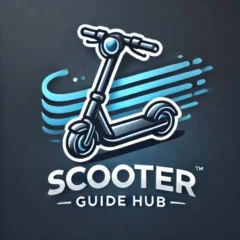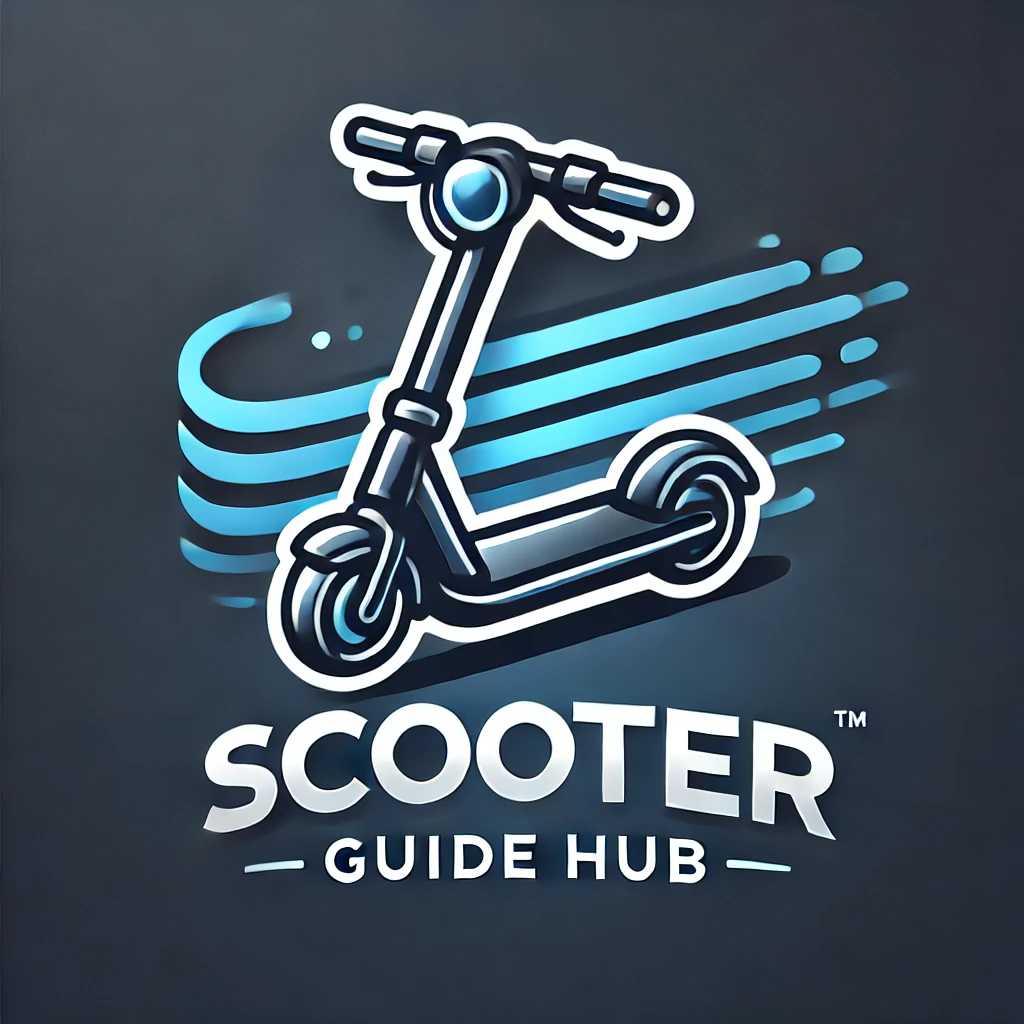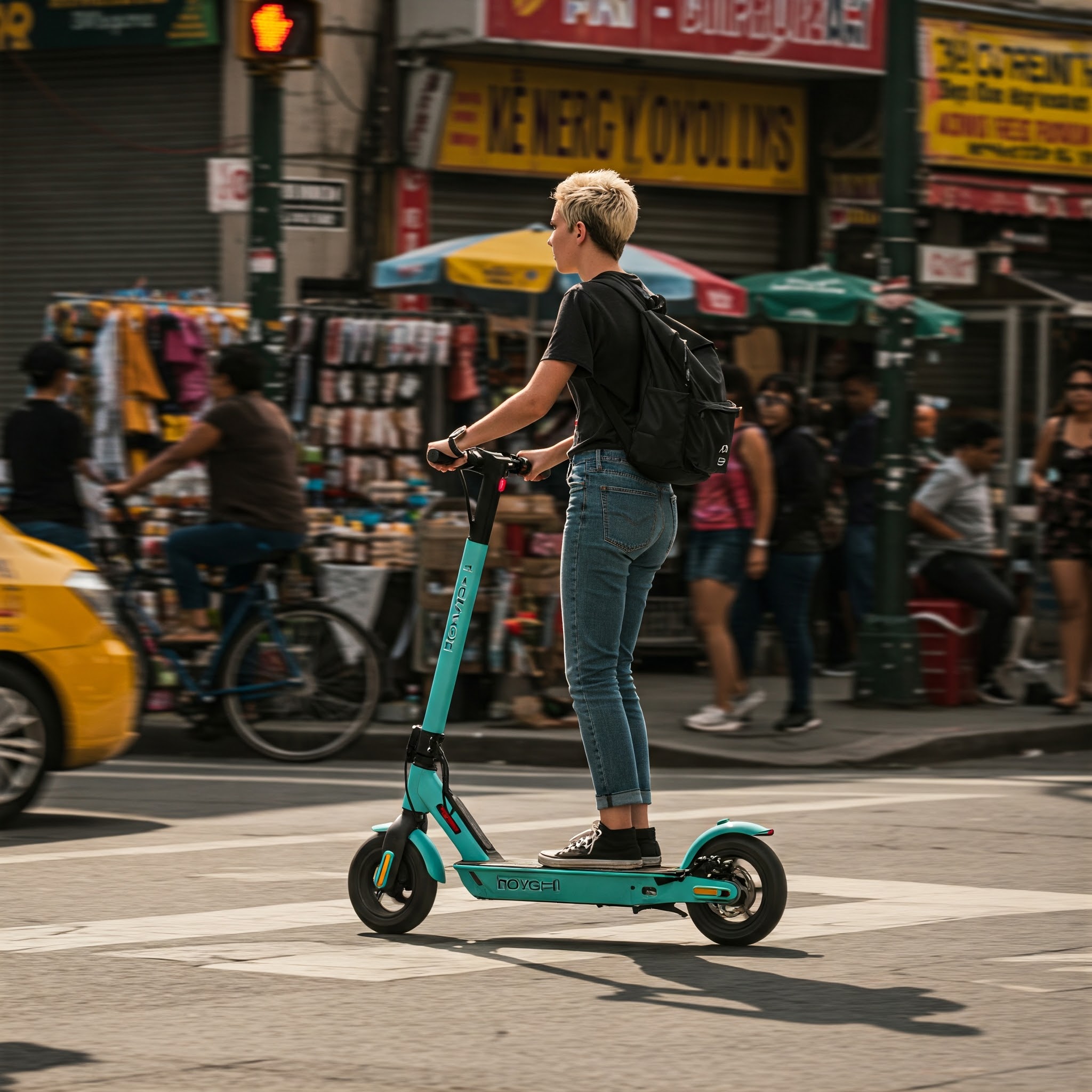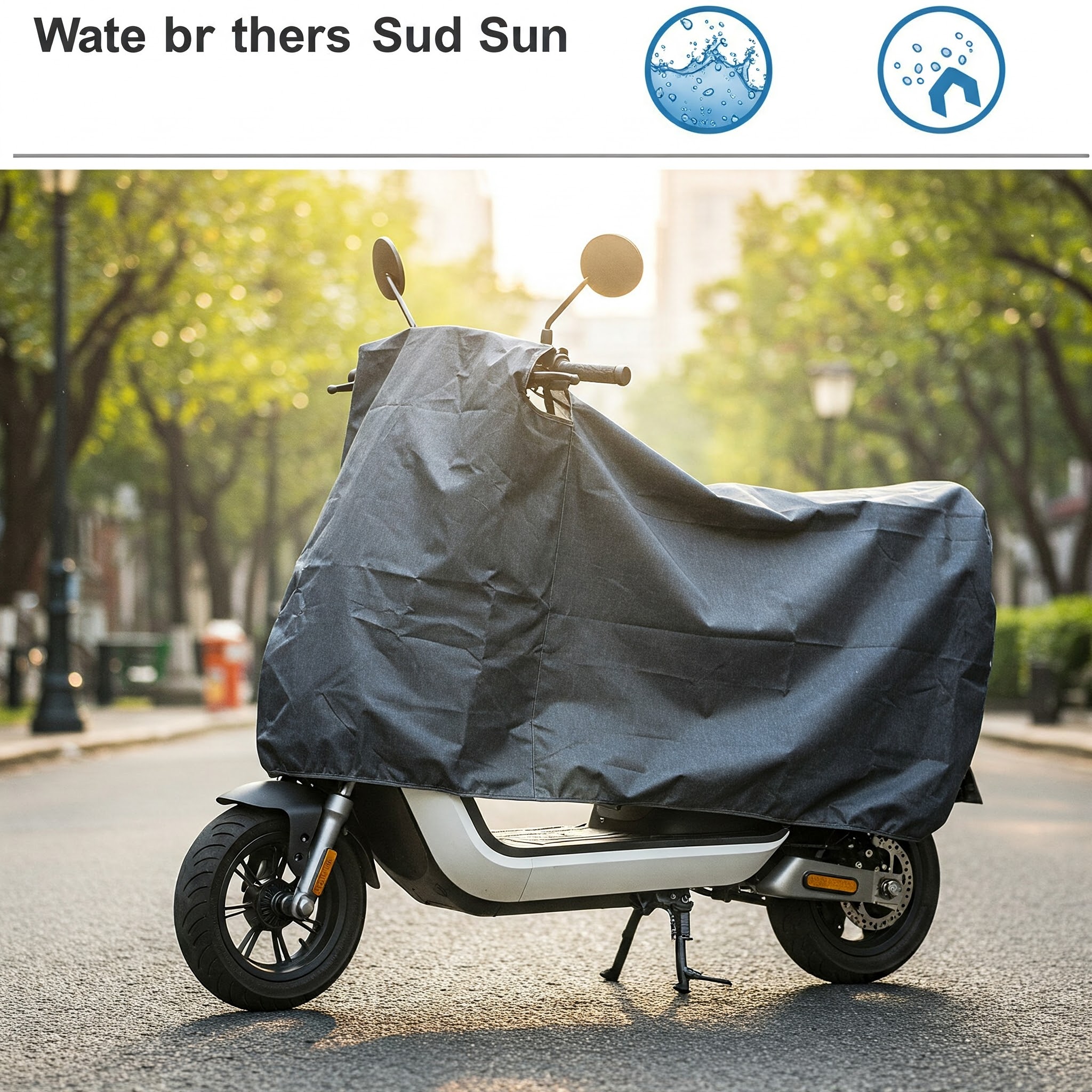Are you struggling with controlling your electric scooter’s speed? The electric scooter throttle is perhaps the most crucial component that determines your riding experience. As someone who has repaired and customized countless electric scooters over the years, I’ve come to appreciate how this small part makes a huge difference in performance, safety, and comfort.
✨Was this helpful? Spread the word! 🚀
When you twist or press your electric scooter throttle, you’re directly communicating with the motor controller about how much power you want. It’s essentially the conversation piece between you and your scooter. But not all throttles are created equal, and choosing the right one can dramatically improve your riding experience.
In this comprehensive guide, we’ll explore everything about electric scooter throttles – from different types and how they work to troubleshooting common issues and recommended replacement options. Whether you’re a daily commuter, weekend adventurer, or a scooter repair enthusiast, this article will enhance your understanding and help you make informed decisions about your electric scooter throttle system.
Comparing Electric Scooter Throttles with Other Control Systems
Before diving deeper, let’s see how electric scooter throttles compare to other personal transportation control mechanisms:
| Control Type | Response Time | Precision | Learning Curve | Weather Sensitivity | Typical Usage |
|---|---|---|---|---|---|
| Electric Scooter Throttle | Immediate | High | Low | Moderate | Urban commuting |
| Bicycle Pedal Assist | Delayed | Moderate | Medium | Low | Recreational riding |
| Hoverboard Weight Shift | Immediate | Low | High | High | Short distances |
| Manual Kick Scooter | User-dependent | User-dependent | Very low | Low | Short trips |
| Electric Skateboard Remote | Slight delay | High | Medium | High | Urban/recreational |
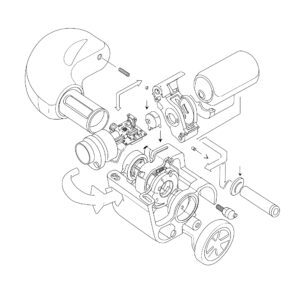
What Is an Electric Scooter Throttle and How Does It Work?
An electric scooter throttle is the control mechanism that regulates the power delivered to your scooter’s motor. Think of it as the gas pedal in your car – it tells your scooter how fast to go. The throttle is typically located on the handlebar and can take several forms including twist grips, thumb levers, or finger triggers.
The Science Behind Electric Scooter Throttles
At its core, an electric scooter throttle is a variable resistor or potentiometer. When you manipulate the throttle, it changes the electrical resistance in the circuit connecting to the controller. This variation in resistance is interpreted by the controller as a signal to increase or decrease power to the motor. Some more advanced models use Hall effect sensors instead of physical contacts, which detect magnetic field changes to determine throttle position.
The throttle’s signal typically ranges from 0.8V (idle) to about 4.2V (full throttle). The controller reads this voltage variation and adjusts the power output accordingly. This is why having a responsive and accurate throttle is crucial for safe riding – it needs to communicate precisely with the controller at all times.
Types of Electric Scooter Throttles
There are several types of electric scooter throttles available, each with its own advantages and ideal use cases:
- Twist Throttles: Similar to motorcycle throttles, these require rotating the handlebar grip to accelerate. They offer intuitive control and are great for riders transitioning from motorcycles.
- Thumb Throttles: These small lever-type controls are pressed with your thumb. They’re popular because they don’t require changing your grip on the handlebars.
- Finger/Trigger Throttles: Operated by pulling a trigger with your index finger, these offer precise control and are common on high-performance scooters.
- Push-Button Throttles: Less common but sometimes found on entry-level models, these simple buttons provide basic on/off acceleration without variable speed control.
- Combination Throttles: These incorporate both acceleration control and additional features like battery indicators or mode switches in one unit.
For most riders, the choice between twist and thumb throttles comes down to personal preference. I’ve found that thumb throttles are easier for beginners and allow more stability since you don’t need to adjust your grip, while twist throttles offer more gradual and precise control once you’re used to them.
Common Electric Scooter Throttle Issues and Solutions
Even the best electric scooter throttle can develop problems over time. Understanding common issues can help you diagnose and fix problems before they become serious:
1. Sticky or Unresponsive Throttle
This is often caused by dirt or debris getting into the throttle mechanism. The solution is usually a careful cleaning with compressed air and electrical contact cleaner. In some cases, disassembly may be required to clean internal components.
2. Inconsistent Power Delivery
If your scooter suddenly accelerates or decelerates without throttle input changes, this could indicate either a failing throttle or controller issues. Testing the throttle with a multimeter to check for smooth voltage transitions can help identify if the throttle is at fault.
3. Dead Zones
Some throttles develop “dead zones” where moving the throttle produces no response. This usually indicates wear in the potentiometer and means it’s time for a replacement.
4. Loose Connections
Throttle wiring can become loose over time, especially with the constant vibrations from riding. Regularly checking and securing these connections can prevent intermittent throttle response issues.
5. Water Damage
While many electric scooter throttles have some water resistance, they’re not typically waterproof. Riding in heavy rain can cause electrical shorts. If your throttle gets wet, dry it thoroughly and let the scooter sit for 24-48 hours before use.
How to Choose the Right Electric Scooter Throttle
Selecting the right electric scooter throttle depends on several factors:
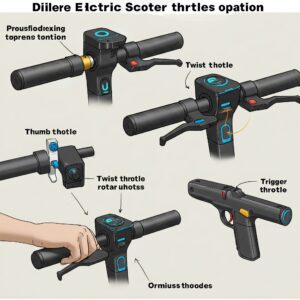
Compatibility Considerations
First and foremost, you need to ensure the throttle is compatible with your scooter’s controller and connector type. This includes:
- Voltage requirements: Typically 36V, 48V, or 52V to match your scooter
- Connector type: Most use 3-pin JST connectors, but this varies by manufacturer
- Signal type: Hall effect or resistive (potentiometer)
- Physical fit: Handlebar diameter and available space
Ergonomic Factors
Consider your riding style and comfort:
- Hand size: Larger hands may prefer twist throttles, while smaller hands might find thumb throttles easier
- Riding duration: For longer rides, choose an ergonomic design that won’t cause hand fatigue
- Weather conditions: If you ride with gloves in cold weather, larger throttles are easier to manipulate
Additional Features
Modern electric scooter throttles often come with built-in:
- Battery level indicators
- Speed mode selectors
- LCD displays showing speed and distance
- Bluetooth connectivity for app integration
These features can enhance your riding experience but will add to the cost. Consider which ones are valuable for your specific needs.
Step-by-Step Guide to Replacing Your Electric Scooter Throttle
If you need to replace your electric scooter throttle, here’s a comprehensive guide:
Tools You’ll Need:
- Small Phillips and flathead screwdrivers
- Allen wrenches (hex keys)
- Wire cutters/strippers (if rewiring is necessary)
- Electrical tape or heat shrink tubing
- Multimeter (for testing)
Safety Precautions:
- Always disconnect the battery before beginning work
- Work in a well-lit area
- Document the original wiring with photos before disconnecting anything
- Keep track of all screws and small parts
Replacement Process:
- Power Down: Turn off your scooter and disconnect the battery to prevent any short circuits.
- Remove Handlebar Grips/Covers: Most throttles are covered by rubber grips or plastic covers that need to be removed first. This usually involves loosening small screws or gently prying off covers.
- Locate the Throttle Connector: Follow the wire from your throttle to find where it connects to the controller. This is typically inside the deck or stem of the scooter.
- Disconnect the Old Throttle: Carefully unplug the throttle connector. Don’t pull on the wires directly – grip the plastic connector housing.
- Remove Mounting Hardware: Unscrew any clamps or brackets holding the throttle to the handlebar.
- Install the New Throttle: Position it on the handlebar in a comfortable location and secure it with the provided hardware.
- Route the Wire: Feed the wire along the same path as the original, using zip ties if necessary to keep it secure and away from moving parts.
- Connect to Controller: Plug the new throttle connector into the controller. Most have keyed connectors that only fit one way.
- Test Before Reassembly: Reconnect the battery and test the throttle function before putting all covers back in place.
- Reassemble: Once you’ve confirmed proper operation, replace all covers and grips.
For visual learners, I recommend checking out this excellent throttle replacement tutorial from Electric Scooter Guide that walks through the process with detailed images.
Comparing Different Electric Scooter Throttle Models
Different models of electric scooters use varying throttle designs. Here’s a comparison of throttle systems across popular scooter models:
| Scooter Model | Throttle Type | Response Sensitivity | Special Features | Ease of Replacement |
|---|---|---|---|---|
| Xiaomi M365 | Thumb | Moderate | Integrated brake lever | Easy |
| Segway Ninebot | Thumb | High | LED display integration | Moderate |
| Dualtron | Finger trigger | Very high | Mode button integration | Difficult |
| Kaabo Mantis | Twist | High | Cruise control function | Moderate |
| Razor E-Series | Twist | Low | Simple on/off | Very easy |
| Apollo | Finger trigger | High | LCD screen integration | Moderate |
| Zero 10X | Thumb | Moderate | Mode selection button | Difficult |
| Emove Cruiser | Thumb | High | Water-resistant design | Moderate |
💬 Just one click – help others make better buying decisions too!😊
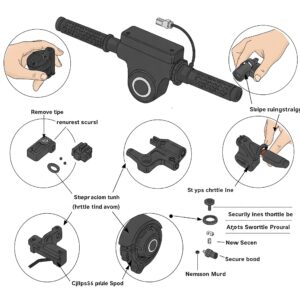
Top Electric Scooter Throttle Replacements Available Today
Based on extensive testing and user feedback, here are my recommendations for the best electric scooter throttle replacements currently available:
YOUYA Electric Scooter Throttle for Xiaomi M365
This thumb throttle is an excellent replacement for Xiaomi M365 and compatible models. It features an improved ergonomic design that reduces thumb fatigue during long rides and includes a built-in battery indicator. Users particularly praise its smooth response curve and durability.
DERUIZ Universal Twist Throttle
For those who prefer twist throttles, this universal model fits most standard handlebars and comes with adaptors for different diameters. Its sealed design offers good water resistance, and the extended grip provides excellent control. It’s compatible with most 36V and 48V systems.
XPRIT LCD Display Throttle Combo
This combination unit includes both a thumb throttle and an integrated LCD display that shows speed, distance, and battery level. It’s a great upgrade for basic scooters, adding functionality while improving throttle response. Compatible with most 24V-48V controllers.
LAIXING Finger Trigger Throttle
This finger trigger model is ideal for performance scooters where precise control is essential. It includes a cruise control button and is designed for riders who prefer not to change their grip position while accelerating. Works with most 36V-60V systems.
EverTrust Hall Sensor Thumb Throttle
This premium throttle uses Hall effect sensors instead of traditional potentiometers, offering exceptional durability and smooth operation. It’s more expensive than basic models but will outlast them significantly. Compatible with most modern controllers that accept Hall effect input.
Benefits of Upgrading Your Electric Scooter Throttle
When comparing stock throttles with aftermarket upgrades, several key benefits emerge:
| Feature | Stock Throttles | Aftermarket Upgrades |
|---|---|---|
| Responsiveness | Good | Excellent |
| Durability | Variable | Usually superior |
| Ergonomics | Basic | Optimized for comfort |
| Water resistance | Minimal | Often improved |
| Additional features | Few or none | Often includes displays/indicators |
| Sensitivity adjustment | Fixed | Sometimes adjustable |
| Price | Included with scooter | $15-$60 additional |
| Warranty coverage | Under scooter warranty | Separate warranty |
How Electric Scooter Throttle Technology Has Evolved
The evolution of electric scooter throttle technology mirrors the advancement of electric scooters themselves:
Early Designs (2000s)
The first electric scooters featured basic on/off switches or very simple potentiometer-based throttles with limited durability. These early designs often had jerky acceleration and provided little feedback to the rider.
Middle Generation (2010-2017)
As electric scooters gained popularity, throttle design improved with smoother acceleration curves and better ergonomics. Thumb throttles became standard on many models, offering more intuitive control than the previous generation.
Current Technology (2018-Present)
Modern electric scooter throttles incorporate Hall effect sensors for improved longevity, integrated displays, connectivity features, and multiple riding modes. They’re designed with user comfort in mind and provide much more precise control.
Future Trends
Looking ahead, we can expect to see further integration of throttles with smart features like:
- Biometric security (fingerprint recognition)
- Haptic feedback for improved rider awareness
- Advanced customization through companion apps
- Self-calibrating systems that adapt to rider preferences
Electric Scooter Throttle Maintenance Tips
Proper maintenance can significantly extend the life of your electric scooter throttle:
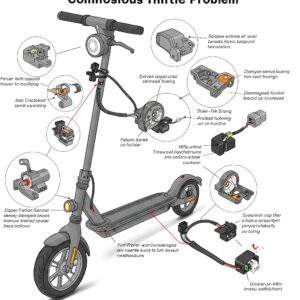
Regular Inspection
Every 1-2 months:
- Check for any physical damage or excessive play in the mechanism
- Ensure all mounting hardware is tight
- Verify that the throttle returns completely when released
- Inspect the wire for any signs of wear or damage
Cleaning Procedures
For thumb and finger throttles:
- Spray a small amount of electrical contact cleaner into the throttle mechanism
- Work the throttle through its full range of motion several times
- Allow to dry completely before using in wet conditions
For twist throttles:
- Remove the grip if possible
- Clean the internal mechanism with compressed air
- Apply a very light coating of silicone lubricant to the moving parts
- Reassemble carefully
Calibration
Some advanced electric scooter throttles can be calibrated for optimal performance:
- With the scooter powered off, hold the throttle at maximum position
- Power on the scooter while holding the throttle
- Wait for the confirmation beep or light signal
- Release the throttle and wait for another confirmation
- Test through the full range to ensure smooth operation
According to a research paper on electric vehicle control systems, proper throttle calibration can improve battery efficiency by up to 7% and provide more consistent acceleration.
Safety Considerations for Electric Scooter Throttles
The throttle directly controls your speed, making it a critical safety component:
Throttle Response Settings
Many modern scooters offer different response modes:
- Eco/Beginner: Gentler acceleration, lower top speed
- Standard/Normal: Balanced performance
- Sport/Expert: Immediate response, maximum power
I always recommend new riders start with the gentlest setting and gradually work up as they become comfortable with throttle control.
Emergency Situations
Practice these safety maneuvers:
- Quick throttle release: Train yourself to instinctively release the throttle in unexpected situations
- Controlled deceleration: Practice gradually reducing throttle rather than abrupt cuts
- One-handed operation: Learn to control the throttle while signaling with your other hand
Weather Adaptations
Adjust your throttle usage based on conditions:
- In wet conditions, use gentler throttle inputs to prevent wheel spin
- In cold weather, be aware that throttle components may be stiffer initially
- In extreme heat, avoid maximum throttle for extended periods to prevent controller overheating
Electric Scooter Throttle vs. Pedal Assist Systems
While this article focuses on throttle systems, it’s worth comparing them to pedal assist systems found on electric bikes:
| Feature | Electric Scooter Throttle | Pedal Assist System |
|---|---|---|
| User input required | Thumb/finger pressure or twist | Pedaling motion |
| Learning curve | Very low | Low to moderate |
| Energy efficiency | Usually less efficient | More efficient |
| Exercise value | Minimal | Moderate to high |
| Precision control | High | Lower (depends on assist levels) |
| Regulatory status | Restricted in some areas | More widely accepted |
| Typical range | Generally shorter | Typically longer |
For those interested in the technical differences, the Journal of Transportation Technologies has published several fascinating studies comparing user experience between throttle and pedal assist systems.
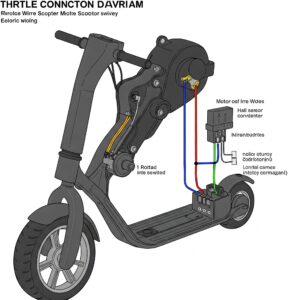
How to Troubleshoot Electric Scooter Throttle Problems
When your electric scooter throttle isn’t working properly, follow this diagnostic flowchart:
- Check the Obvious
- Is the scooter powered on?
- Is the battery sufficiently charged?
- Are there any error codes on the display?
- Visual Inspection
- Look for damaged wires or connectors
- Check for water ingress
- Verify the throttle moves freely without binding
- Connection Test
- Disconnect and reconnect the throttle connector
- Check for corrosion or damage on the connector pins
- Verify the connector is fully seated
- Voltage Testing (requires a multimeter)
- With the scooter powered on, measure voltage at the throttle connector
- Check for smooth voltage transition as you operate the throttle
- Typical readings should be 0.8V at rest and 4.2V at full throttle
- Isolation Test
- If possible, connect a known working throttle to determine if the issue is with the throttle or controller
“An ounce of prevention is worth a pound of cure.” This is especially true for electric scooter throttles. Regular maintenance checks can identify potential issues before they leave you stranded.
Legal Considerations for Electric Scooter Throttles
The legal status of throttle-controlled electric scooters varies widely:
United States Regulations
In the U.S., laws vary by state and even by city:
- Some areas classify throttle-controlled scooters as motor vehicles requiring registration
- Others have specific electric scooter ordinances with speed limitations
- Many cities restrict throttle scooters to bike lanes or roads
The Consumer Product Safety Commission provides guidelines for electric scooter safety standards, though these focus more on construction than specifically on throttle design.
European Regulations
The EU has more standardized but often stricter regulations:
- Many countries limit electric scooters to 25 km/h (15.5 mph)
- Some require throttles to be progressive rather than on/off
- Certain areas prohibit throttle-only control, requiring pedal assist
Throttle Modifications and Liability
It’s important to note that modifying your throttle to bypass speed restrictions:
- May void your warranty
- Could invalidate your insurance
- Might be illegal in your jurisdiction
- Potentially increases your liability in case of an accident
Always research local regulations before modifying any control components on your electric scooter.
✨ Take Your Ride to the Next Level with Quality Throttle Upgrades! 🔧
➡ Ready to experience smoother acceleration and better control? The throttle replacements featured in this article don’t just solve problems—they can transform your entire riding experience. Click on any of the highlighted products to check current pricing and availability on Amazon. Your perfect throttle upgrade is just a click away!
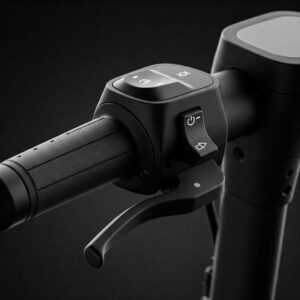
DIY Electric Scooter Throttle Modifications
For the technically inclined, there are several throttle modifications that can enhance your riding experience:
Response Curve Adjustment
Some controllers allow you to adjust the throttle response curve:
- Connect your scooter to its companion app (if available)
- Look for acceleration or throttle response settings
- Adjust according to your preference – linear for predictable response or exponential for more aggressive acceleration
Throttle Limiters
For shared scooters or when lending to less experienced riders:
- Install a throttle limiter adapter between the throttle and controller
- Set the maximum output voltage to correspond with your desired speed limit
- This allows full throttle movement but caps the maximum signal sent to the controller
Cruise Control Implementation
If your scooter doesn’t have cruise control:
- Purchase a throttle with integrated cruise control button
- Or install an aftermarket cruise control module
- Follow the included wiring diagram to integrate with your existing throttle
According to the Electric Vehicle Research Journal, cruise control can reduce battery consumption by up to 15% on long, constant-speed rides.
The Future of Electric Scooter Throttle Technology
The electric scooter throttle continues to evolve with exciting new technologies on the horizon:
Smart Adaptive Throttles
Next-generation throttles will likely adapt to:
- Rider preferences
- Terrain conditions
- Battery state
- Traffic density
These systems will use AI algorithms to provide the optimal throttle response for each situation.
Integrated Safety Systems
Future throttles may incorporate:
- Collision detection that automatically modulates throttle response
- Traction control systems that prevent wheel slip
- Geofencing capabilities that adjust maximum throttle output based on location
Improved Human-Machine Interface
Look for advances in how we interact with our scooters:
- Voice-controlled throttle adjustments
- Gesture recognition for hands-free speed control
- Haptic feedback that communicates important information through the throttle
Sustainability Improvements
Environmental considerations are driving development of:
- Longer-lasting components with reduced electronic waste
- More energy-efficient control systems
- Eco modes that optimize for range rather than performance
✨ Take Control of Your Ride with Premium Throttle Options! 🛴
➡ The difference between a good ride and a great one often comes down to how well you can control your scooter. Each of the recommended throttle options in this guide offers unique benefits for different riding styles. Click any product link to see current pricing and reviews from other riders. Your perfect throttle match is waiting!
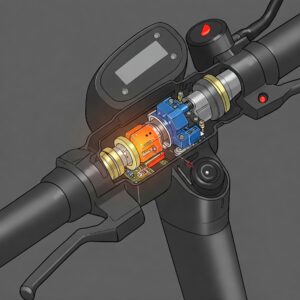
Conclusion: Choosing the Right Electric Scooter Throttle for Your Needs
The electric scooter throttle might seem like a small component, but its impact on your riding experience is immense. Whether you’re replacing a worn-out throttle or upgrading to improve performance, understanding the options available helps you make an informed decision.
Remember these key takeaways:
- Thumb throttles offer convenience and stability but may cause fatigue on longer rides
- Twist throttles provide precise control but require adjusting your grip
- Finger triggers balance comfort with control but may be harder to operate with gloves
- Quality matters – a premium throttle improves safety, comfort, and durability
- Compatibility is crucial – always verify voltage requirements and connector types
By choosing the right electric scooter throttle and maintaining it properly, you’ll enjoy smoother rides, better control, and increased safety. The perfect throttle makes acceleration feel natural and intuitive, allowing you to focus on enjoying the journey rather than thinking about how to control your scooter.
Electric Scooter Throttle FAQ
❓ How do I know if my electric scooter throttle is bad?
✅ Look for symptoms like inconsistent acceleration, dead spots during throttle movement, failure to return to zero position, unusual noises, or complete non-response. Using a multimeter to test voltage output (typically 0.8V-4.2V) can confirm throttle failure...
❓ Can I upgrade my electric scooter throttle for better performance?
✅ Yes, aftermarket throttles can provide smoother acceleration, better ergonomics, and additional features like displays or cruise control. Ensure any replacement is compatible with your scooter's voltage and controller system...
❓ What's the difference between Hall sensor and potentiometer throttles?
✅ Hall sensor throttles use magnetic field detection without physical contact, offering better durability and smoother operation. Potentiometer throttles use physical contact to vary resistance, which can wear out faster but are typically less expensive...
❓ How much does an electric scooter throttle replacement cost?
✅ Basic replacement throttles range from $15-30, while advanced models with displays or special features can cost $40-60. Professional installation adds $25-50 if you're not comfortable with DIY replacement...
❓ Is it difficult to replace an electric scooter throttle myself?
✅ Most throttle replacements are moderately easy DIY projects requiring basic tools like screwdrivers and Allen wrenches. The main challenge is ensuring proper wire routing and connections. Complete replacement typically takes 30-60 minutes for beginners...
Recommended for You
- 10 Essential Electric Moped Scooter Parts Every Smart Rider Should Know About in 2025
- 10 Best Electric Scooter Lights for Maximum Visibility & Safety in 2025
- 10 Best Waterproof Electric Scooter Models For All-Weather Commuting in 2025
Disclaimer: This article contains affiliate links. If you purchase products through these links, we may earn a small commission at no additional cost to you.
✨ Found this helpful? Share it with your friends! 💬🤗
